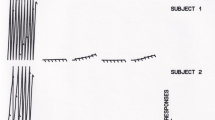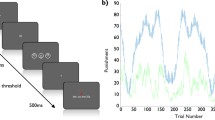Abstract
When human subjects lose money in 50% of multiple-schedule components, the most common finding is a decreased response rate in the other components (i.e., punishment induction). When money is lost in only 10% of components, however, the most common finding is an increased response rate in the other components (i.e., punishment contrast). The purpose of the present study was to provide an experimental assessment of the relation between proportion of punishment components and contrast and induction. Four adult humans pressed a lever or pulled a plunger for money on a multiple VI VI schedule arranged with green and red rectangles. The proportion of red rectangles was either 10% or 50%. After responding was stable in both components, every response in the red component was followed by money loss. Across 10 punishment conditions, there was no systematic relation between proportion of punishment components and contrast and induction. With both the 10% and 50% proportions, induction occurred in four punishment conditions and contrast occurred in one. There were, however, systematic effects of condition sequence. For all subjects, the pattern across punishment conditions was induction, then contrast or less induction, then induction. Present results show that proportion of punishment components cannot account for discrepancies found in previous studies, and that effects of punishment on unpunished responses change over time, perhaps because of punisher novelty.
Similar content being viewed by others
References
AMSEL, A. (1958). The role of fmstrative nonreward in noncontinuous reward situations. Psychological Bulletin, 55, 102–119.
AZRIN, N. H. (1960). Effects of punishment intensity during variable-interval reinforcement. Journal of the Experimental Analysis of Behavior, 3, 123–142.
AZRIN, N. H., & HOLZ, W. C. (1966). Punishment. In W. K. Honig (Ed.), Operant behavior: Areas of research and application (pp. 380–447). Englewood Cliffs, NJ: Prentice Hall.
BLOOMFIELD, T. M., (1967). Some temporal properties of behavioral contrast. Journal of the Experimental Analysis of Behavior, 12, 151–158.
BLOOMFIELD, T. M. (1969). Behavioral contrast and the peak shift. In R. M. Gilbert & N. S. Sutherland (Eds.), Animal discrimination learning (pp. 215–241). New York: Academic Press.
BRETHOWER, D. M., & REYNOLDS, G. S. (1962). A facilitative effect of punishment on unpunished behavior. Journal of the Experimental Analysis of Behavior, 5, 191–199.
CROSBIE, J. (1993). The effects of response cost and response restriction on a multiple-response repertoire with humans. Journal of the Experimental Analysis of Behavior, 59, 173–192.
CROSBIE, J. (1998). Negative reinforcement and punishment. In K. A. Lattal & M. Perone (Eds.), Handbook of human operant behavior research methods. New York: Plenum.
CROSBIE, J., WILLIAMS, A. M., LATTAL, K. A., ANDERSON, M. M., & BROWN, S. M. (1997). Schedule interactions involving punishment with pigeons and humans. Journal of the Experimental Analysis of Behavior, 68, 161–175.
FLESHLER, M., & HOFFMAN, H. S. (1962). A progression for generating variable interval schedules. Journal of the Experimental Analysis of Behavior, 5, 529–530.
GRAY, J. A. (1991). The psychology of fear and stress. New York: Cambridge University Press.
HONIG, W. K., & SLIVKA, R. M. (1964). Stimulus generalization of the effects of punishment. Journal of the Experimental Analysis of Behavior, 7, 21–25.
KELLER, K. (1974). The role of elicited responding in behavioral contrast. Journal of the Experimental Analysis of Behavior, 21, 249–257.
KILLEEN, P. R. (1978). Stability criteria. Journal of the Experimental Analysis of Behavior, 29, 17–25.
LATTAL, K. A. (1970). Relative frequency of reinforcement and rate of punished behavior. Journal of the Experimental Analysis of Behavior, 13, 319–324.
LINDSLEY, O. R. (1956). Operant conditioning methods applied to research in chronic schizophrenia. Psychiatric Research Reports, 5, 118–139.
O’DONNELL, J. M. & CROSBIE, J. (1998). Punishment generalization gradients with humans. The Psychological Record, 48, 211–232.
PREMACK, D. (1969). On some boundary conditions of contrast. In J. T. Tapp (Ed.), Reinforcement and behavior (pp. 120–145). New York; Academic Press.
RACHLIN, H. (1973). Contrast and matching. Psychological Review, 80, 217–234.
REYNOLDS, G. S. (1961). An analysis of interactions in a multiple schedule. Journal of the Experimental Analysis of Behavior, 4, 107–117.
REYNOLDS, G. S. (1963). Some limitations on behavioral contrast and induction during successive discrimination Journal of the Experimental Analysis of Behavior, 6, 131–139.
REYNOLDS, G. S., & CATANIA, A. C. (1961). Behavioral contrast with fixed-interva! and low-rate reinforcement. Journal of the Experimental Analysis of Behavior, 4, 387–391.
REYNOLDS, LIMPO, A. J. (1968). On some causes of behavioral contrast. Journal of the Experimental Analysis of Behavior, 11, 543–547.
SCHWARTZ, B., & WILLIAMS, P. R. (1972). Two different kinds of key-peck in the pigeon: Some properties of responses maintained by negative and positive response-re inforcer contingencies. Journal of the Experimental Analysis of Behavior, 18, 201–216.
TERRACE, H. S. (1966). Behavioral contrast and the peak shift: Effects of extended discrimination training. Journal of the Experimental Analysis of Behavior, 9, 613–617.
TERRACE, H. S. (1968). Discrimination learning, the peak shift, and behavioral contrast. Journal of the Experimental Analysis of Behavior, 11, 727–741.
Author information
Authors and Affiliations
Corresponding author
Additional information
The present research was supported by NIH grant MH54195 awarded to John Crosbie, and by grants from Sigma Xi Scientific Research Society and the WVU Psychology Department Alumni Fund awarded to Janet Emmendorfer. These results were presented at the 1997 meeting of the Association for Behavior Analysis in Chicago and reported in a Masters thesis by the first author
We are grateful to Erin Kane for helping with data collection
Rights and permissions
About this article
Cite this article
Emmendorfer, J.L., Crosbie, J. Effects of Punishment Proportion and Condition Sequence on Contrast and Induction with Humans. Psychol Rec 49, 261–271 (1999). https://doi.org/10.1007/BF03395320
Published:
Issue Date:
DOI: https://doi.org/10.1007/BF03395320




